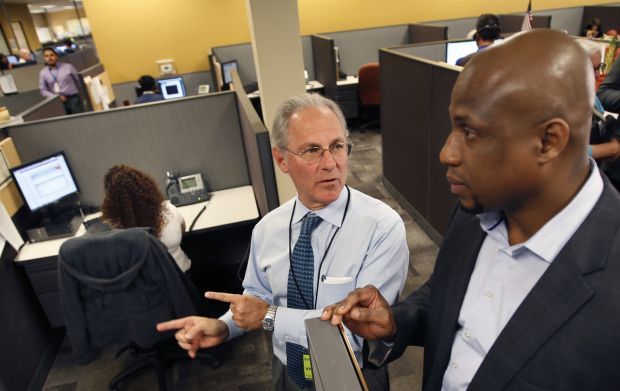Tucson Mayor Jonathan Rothschild is promoting five T’s to replace the traditional five C’s of Arizona’s economy — copper, cattle, cotton, citrus and climate.
The five T’s — technology, trade, tourism, teaching and transportation — are the theme of this year’s Star 200.
Here’s how Rothschild sees the plan shaping up:
TECHNOLOGY
Q: What efforts are underway to preserve jobs in the aerospace and defense industries?
A: The military is downsizing. To ensure that our installations remain relevant, we need the right advocates in D.C. — people who understand the military and where it’s headed, what new technologies are coming, what missions are based where. Tucson has many strengths to offer our armed forces. We have great flying weather and a statewide defense network. We have depth and breadth locally in aerospace, border security, UAV and other technologies. Still, it would be naïve to think that we can effectively make our case to Congress and the Pentagon without specialized representation in D.C.
With respect to civil aviation, I’ve been meeting with regional prime and subcontractors to encourage increased procurement locally. It’s a matter of primes understanding what local subs can offer and subs understanding what primes need. Building our supply chain builds our industry cluster, and that makes us more attractive as a region — for this and other industries.
TRADE
Q: What’s your progress report on improving Tucson’s ties with Mexico?
A: Showing up counts for a lot. I’ve made many trips to Mexico, to Sonora, Sinaloa and Mexico City, bringing with me delegations from academia, business and government. The fact is, Tucson is known for our diversity and our opposition to SB 1070, so we’ve been warmly received wherever we go.
We have connections — we just need to strengthen them. The Star’s Arizona-Sonora Business Resource Guide will help. So will the city’s opening trade offices in Hermosillo and Ciudad Obregon in partnership with Visit Tucson. We need to do the same in Mexico City, with the University of Arizona, the city of Phoenix, or some other partner.
Q: It seems like there’s an image problem on both sides of the border, with Arizonans having a perception of Mexico as a violent place and Mexicans having a perception of Arizona as an unwelcoming place. How can Tucson overcome that?
A: Much of the violence in Mexico has been connected with the drug trade. Avoiding that greatly reduces risk. There’s enough familiarity with Mexico here in Tucson that I think most people understand that.
Fortunately, Tucson has been seen as a welcoming city even when Arizona has not been seen as a welcoming state. We do need to repair our state’s image in Mexico, and I know Mayor Greg Stanton in Phoenix has been working on that, along with other mayors. Our governor has met with Mexican officials, and that’s encouraging. It will take time, however, to repair damage done by SB 1070.
TOURISM
Q: Bed tax revenue hasn’t recovered. But that’s the funding for investing in tourism and marketing efforts. This sounds like a chicken-and-egg problem. What new strategies are local leaders using?
A: CEO Brent DeRaad at Visit Tucson is doing a great job. Their rebranding effort really captured what sets Tucson apart from other sun-filled destinations.
We can’t be all things to all people, but we can decide what we’re good at, what we want to be good at, and work hard in areas that make sense. Youth and amateur sports are a good fit for Tucson, and can fill a lot of empty beds when the whole family flies out to see a son or daughter play in a tournament. We can promote our festivals more — book, film, music and others.
Rather than chicken-and-egg, I’d say it’s a virtuous circle. As we get better and better at targeting who wants to come here and why, we’ll increase our bed tax revenue, and some of that revenue will get put back into the smart marketing that brought revenue in in the first place.
TEACHING
Q: You’ve talked a lot about the importance of having good schools to attract and keep good workers. Is business on board?
A: The business community understands the importance of public education. Now, they need to act. Business leaders I speak with agree that a good education system is good for business, but their advocacy for our public schools must be much stronger. What ultimately stopped the anti-immigration legislation coming out of Phoenix was the business community of this state saying, “Enough. This is hurting business.” We need to see that kind of resolve on behalf of public education.
TRANSPORTATION
Q: There are a lot of big ideas right now. Aerospace highway, interstate build-outs, rail connections. How can we afford them? What’s the federal funding outlook?
A: We need federal, state and regional partners all working together to obtain necessary transportation funding. For me, it’s a matter of first things first. That means State Route 189 where it exits the Mariposa Port of Entry, as well as building out Interstate 10 and Interstate 19. I’m hoping to see the next round of federal TIGER grants address some of these issues.
Rail is also important, as we’re seeing with the Port of Tucson and the success they’re having. Of course, this is all capitalizing on advantages Tucson already has — being located 60 miles from Mexico, the nearest major U.S. city to the Guaymas Port, and sitting at the intersection of the Union Pacific Rail System and two interstate highways.






